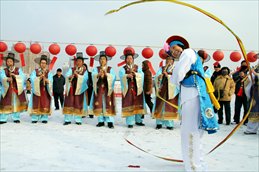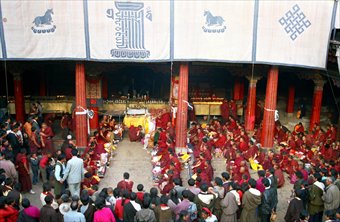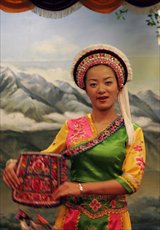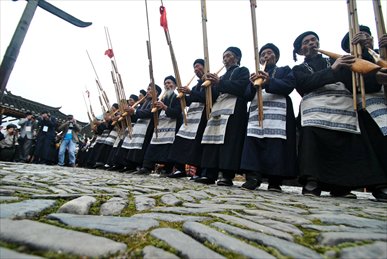Diverse delights
With the Chinese lunar new year approaching, workers in the big cities have begun packing up and embarking on the journey home to unite with their families. Meanwhile at home, their families are busy preparing for the upcoming Spring Festival on January 31.
Being the biggest day of the year for Chinese people, traditional customs such as making lunar new-year cakes - made of glutinous rice flour - are essential. Despite all their busy preparation and excitement, some may still feel the once-strong atmosphere of the jubilant Spring Festival is fading in the city.
This year, if you want to experience that once-hefty dose of festivity on the special day, visiting ethnic minority regions might be a fun choice.

Photo: CFP
The timing of the Spring Festival for the Korean ethnic minority of China is the same as the Han ethnic majority. On the eve of the new year, Korean people have the tradition of staying up all night long to see in the new year.
During the 15-day holiday, Korean people in Yanbian Korean Autonomous Prefecture of Jilin Province in northeastern China have "wild fire plays" created by special lighting in the fields.The biggest holiday of the year is Koreans' happiest time to sing and dance. Sports and games like see-saw and tug-of-war are favorites.
On the 15th day of the lunar new year, the Lantern Festival, Korean people have their traditional gathering celebrations, selecting several senior men to board the moon-viewing stand.
For the first man to see the moon, his descendants are blessed with health and prosperity. Then everybody surrounds the lit stand, dancing to the long drum, drum flute and oboe-like suona.

Photo: CFP
The lunar new year according to the Tibetan calendar usually approximates with the traditional lunar new year of the Han ethnic majority. Sometimes they even occur on the exact same day.
This year, however, it falls over one month behind, meaning March 2 is the day of the Tibetan festival.
Popular Buddhist sentiment means the day has a strong religious aura.
Usually local people's preparations for the lunar new year start early in the beginning of the 12th lunar month.
Besides dining, drinking and entertaining, every household traditionally makes a bucket of grain called qiema in Chinese and prays for a bumper harvest.
Tibetan people also like to prepare a Tibetan doughnut called kabusai, boiled mutton, butter tea and barley wine for their biggest festival of the year.
On the eve of the Tibetan new year, if there's a monk in the family, he will chant Buddhist sutras in front of a shrine featuring highland barley, butter and an auspicious eight-treasure wooden board. Meanwhile, a butter-oil lamp and Tibetan incense will both be lit.
Folk artists perform on the first day of new year, mainly singing Tibetan operas or perhaps even performing zhega, a kind of ancient story-based rap. Rich people hire performers to entertain their families. Masked zhega performers hold a wooden staff and improvise lyrics in return for rewards.
The fourth day of the lunar new year, Monlam, is when nearly 20,000 monks gather at the Jokhang Temple in Lhasa of Tibet Autonomous Region to pray in front of Sakyamuni. Like the Han festival, the Tibetan lunar new year festivities also last 15 days.

Photo: CFP
With its mild climate and abundant ethnic diversity, Yunnan Province is still one of the best travel destinations in China.
The Dali Bai Autonomous Prefecture, where most residents are members of the Bai ethnic minority, is recommended by media as the place with the strongest festival atmosphere during the Chinese new year.
Dali people have a traditional schedule during Spring Festival. On the lunar new year's eve, rice vermicelli and green vegetables are boiled into a soup, which represents honesty.
On lunar new year's day, people burn incense and drink fried rice tea. Firecrackers welcome the sky, earth and nature.
Visiting relatives and friends starts the next day. Hosts and hostesses traditionally offer guests san dao cha, roughly translated as the three processes of having tea.
The tea tradition is important in many Bai events. The first step is a cup of bitter tea boiled with only tea leaves. The second step involves hosts boiling up a new brew, adding milk, brown sugar and condiments like cinnamon. Guests are given a second, sweeter cup.
The final cup, called "aftertaste tea" includes honey, fried rice and walnuts.
The most important thing for the Bai people of the fishing village of Shuanglang is welcoming the main gods from traditional Bai mythology on the fourth day of the lunar new year, the birthday of Hongshan. Women often dress up to celebrate the day.
Men travel to Hongshan temples by boat and bring back decorated floats that are paraded through the village. All the villagers come out of their houses and join in the singing, dancing and praying to the relevant gods for a good new year.

Photo: CFP
Leishan county in Guizhou Province of Southwest China has the largest Miao ethnic minority village, which includes more than 1,000 families.
During lunar new year, visitors can experience "Twelve Lanmen Wine," a typical Miao welcome for guests to drink wine 12 times, each with a different toasting song, before they enter a themed-for-tourism home in the Langde Miao village between January 31 and February 2 or Xijiang Miao village between February 1 and 6.
Twelve is a special number for the Miao: the twelve months of the year, the twelve zodiac signs and also the cycle of Miao sacrifices to their ancestors. "Twelve Lanmen Wine" is thus the largest number on the scale for welcoming a distinguished guest. The welcome ceremony rice wine is usually light and sweet, meaning most visitors need not worry about getting drunk. Just savor the heroic stories and oral history contained in the toasting songs. A long table feast is another welcome ceremony in Miao villages. People line tables, usually several meters long, and sit on both sides.
Some feasts in Langde Miao village are held on bridges. Many bridges in this area have pavilions on them, making them comfy stopping-off points.
Village visitors can join in making glutinous rice balls or dance in the squares to tunes played on a lusheng, a Miao ethnic wind instrument. The dance steps are easy enough for even the most lead-footed foreign visitor.